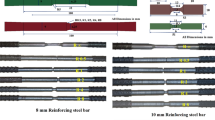Abstract
The strength and behavior of split-tee connections that are applicable to all tensile connections with high-strength bolts have been studied in many countries. The design code of each country (AISC, Eurocode 3) does not consider various field conditions, however, such as the painting of the connection surface, the length of the bolt shank, and the preload. Moreover, the previous studies (Bahaari) that used the link element on the preload of the bolt could not predict the correct behavior of high-strength bolts. In this study, to evaluate the tensile capability of split-tee connections, a total of 20 split-tee specimens with two bolts each were fabricated and tested. The experiment parameters that were used were the thickness of the T-flanges, painting, preload, and the length of the bolt shank. The joint stiffness of split-tee connections was compared with the stiffness equation of Faella et al., and finite-element method analysis with Ansys 8.0 was conducted. Further, to verify the reliability of the highstrength-bolt model, the load-to-bolt stress relation in the experiment test and the analysis results were compared.
Similar content being viewed by others
References
Agerskov, H. (1976). “High-Strength Bolted Connections Subject to Prying.” Journal of the Structural Division, ASCE, 102(1), pp. 161–175.
Agerskov, H. (1977). “Analysis of bolted connections subject to prying.” Journal of the Structural Division, ASCE, 103(11), pp. 2145–2163.
AISC (2005). Seismic Provisions for Structural Steel Buildings, AISC.
ANSYS INC (2001). ANSYS Release 6.0-user’s manual.
Bahaari, M. R. and Sherbourne, A. N. (1996). “Structural Behavior of End-Plate Bolted Connections to Stiffened Columns.” Journal of the Structural Engineering, ASCE, pp. 926–935.
Barron, J. and Bickford, J. H. (1998). Handbook of Bolts and Bolted Joints: Computing the Strength of a Fastener, Marcel Dekker, New York, N.Y., USA.
Broderick, B. M. and Tomson, A. W. (2005). “Moment- Rotation Response of Flush End-Plate Joints Under Cyclic Loading.” International Journal of Steel Structures, KSSC, 5(5), pp. 441–451.
BS standard (1992). Eurocode 3: Design of steel structures (part 1.1 General rules and rules for buildings).
Choi, C. K. and Chung, G. T. (1996). “Refined Three- Dimensional Finite Element Model for End-Plate Connection.” Journal of the Structural Engineering, ASCE. pp. 1307–1316.
Choi, H. K., Choi, S. M., and Kim, J. H. (2003). “Structural Tensile Capacities of Split-Tee Connection with High Strength Bolts.” Journal of Korean Society of Steel Construction, KSSC, 15(5), pp. 541–549.
Faella, C., Piluso, V., and Rizzano, G. (2000). Structural Steel Semirigid Connections, CRC Press LLC.
Faella, C., Piluso, V., and Rizzano, G. (1998). “Experimental Analysis of Bolted Connections: Snug Versus Preloaded Bolts.” Journal of Structural Engineering, ASCE, 124(7), pp. 765–774.
Kulak, G. L., Fisher, J. W., and Struik, J. H. A. (1987). Guide to Design Criteria for Bolted and Riveted Joints. Second Edition, John Wiley & Sons.
Kukreti, A. R., Gheassemieh, M., and Murray, T. M. (1989). “Finite Element Modeling of Large Capacity Stiffened Steel Tee-Hanger Connections.” Computer and Structures, 32(2), pp. 409–422.
Swanson, J. A. and Leon, R. T. (2001). “Stiffness Modeling of Bolted T-Stub Connection Components,” Journal of Structural Engineering, 127(5), pp. 498–505.
Tahir, M. Md. and Hussein, Md. A. (2008). “Experimental Tests on Extended End-Plate Connections with variable Parameters.” International Journal of Steel Structures, KSSC, 8(4), pp. 369–381.
Author information
Authors and Affiliations
Corresponding author
Rights and permissions
About this article
Cite this article
Lee, SH., Kim, JH. & Choi, SM. Structural behavior of tension joint with high-strength bolted split-tee. Int J Steel Struct 9, 93–105 (2009). https://doi.org/10.1007/BF03249484
Received:
Accepted:
Issue Date:
DOI: https://doi.org/10.1007/BF03249484




